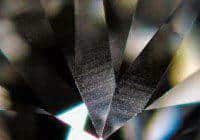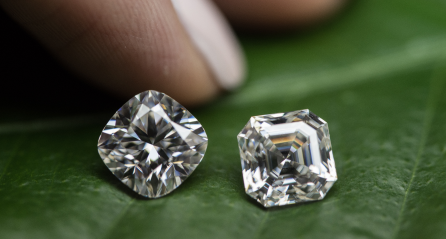Clarity
On this page you will find:
- Diamond clarity explained
- The diamond clarity chart
- Types of flaws
- 3 Tips to use clarity to find your perfect diamond
- Gia explains clarity
- The Bottom Line
- How our diamond selection makes your decision easier
- Further diamond education
Diamond Clarity
Diamond Clarity refers to the presence of imperfections in a diamond. Most diamonds contain some degree of imperfection, and are graded using a scale that runs from FL (meaning flawless) to I (meaning easily visible imperfections). This means the fewer inclusions a diamond has, the greater the clarity and this makes it more valuable.
The quality will have an impact on the resulting brilliance and shine of the diamond as well as the overall physical appearance. Some of these imperfections naturally occur while some occur during the cutting procedure. As a matter of fact, a completely flawless diamond has no surface blemishes and therefore is extremely rare and obviously more costly. The beauty of the diamond is not greatly affected by the actual inclusions as they are either too small to be visible by the naked eye, or they can be hidden when setting the diamond in a ring
Clarity chart
One of the leading labs in the world : the gemological institute of America(GIA) had created a scale to express the clarity grade of a diamond. The following terms are used :
- Flawless (FL)
— indicates that diamonds neither have internal nor external blemishes. Essentially, flawless means that the diamonds are perfect in so far as clarity is involved. This is also sometimes referred to as loupe clean. - Internally flawless (IF)
— considering the name, this diamond grade means that the gem has no internal imperfections but may exhibit minor external ones. More often than not, IF (internally flawless) and FL (flawless) are categorized as one grade. - VVS1 & VVS2
— stands for «Very, Very Slightly included». This means that there are minimal imperfections found on the diamonds. Because such imperfections are minute, even experienced graders will find it hard to see while using their jeweler tools. As expected, flaws for this clarity grade are almost impossible to detect even by the sharpest unaided pair of eyes. VVS1 diamonds are considered slightly better than VVS2 with both being extremely high clarity of diamond grades with great values. - VS1 & VS2
— refer to «Very Slightly included». Flaws for this category are also minimal but greater than VVS flaws. Such imperfections or not visible to the naked eye. - SI1 & SI2
— are «Slightly Included» categories. Their imperfections are easily spotted through 1x magnification and si2's might even be noticed by the naked eye. - I1, I2, & I3
— is the «Included» category. This means that significant flaws are visible whether within or on the diamond surface. Although quick glances will overlook the flaws, they become obvious through closer inspections even with unaided eyes
The rating of the clarity characteristics is determined by the size, number and location of internal and external inclusions or blemishes. The internal characteristics include crystals, clouds and feathers. External characteristics or surface irregularities are also called blemishes. As most flaws are only visible under 10x magnification a microscope is used to do the grading .
Diamond Clarity Chart


Types of flaws found in diamonds
There are many different types of flaws that can appear in a diamond. Below we have listed some of the most common ones.
- Crystals: These are minerals spots in the diamond. The two most common ones are white crystals (the best because they blend in) or black carbon spots (which if larger, would look like a speck of dust you can't rub off
- Pinpoints: Very, very tiny crystals that just look like a dot at 10x. They are almost impossible to detect and thus are not a problem.
- Clouds: This is a cluster of pinpoints that may look like one larger flaw. If it's too big or dense, this may be noticeable and even make a diamond appear a bit hazy.
- Needle: A long and thin crystal (like a needle) which is usually white in color.
- Feathers: Internal cracks. Watch out for where the feather is located. If it's near the edge, this may make the diamond susceptible to chipping.
- Graining: Caused by natural abnormal growth of the diamond's crystal structure. Graining could look like lines or a reflective white area, and can make a diamond appear hazy. It can either be internal or on the surface.
- Twining wisp: Flaws caused by irregular growth of the diamond's crystal structure. This is usually a group of clouds, pinpoints, feathers, and crystals.
- Cavity: A small hole/void in the diamond. Usually, this happens when a crystal at the surface falls out during polishing.
- Chip: A surface blemish usually either caused during the cutting process or during wear and tear. Diamonds are the hardest thing on Earth, but it can still chip given a sharp blow in the right direction.
- Polishing lines: Tiny lines on the surface made during polishing
- Scratch: An abrasion on the surface.
- Bearding: Very small fractures/feathers on the girdle (the edge of the diamond between the top and bottom halves). This happens when there was too much pressured applied when making the girdle and the edge becomes rough.
Some examples:
Polishing lines : found on a diamond with an IF grading


Feather : general terms used for a break in the diamond


Crystals : minerals trapped inside the diamond


3 tips using clarity to find your perfect diamond
- In order to buy a premium diamond, make sure you select a SI1 diamond or better.
- Make sure your diamond is certified by IGI, HRD or GIA
- Don't select any diamonds with inclusions ( Si2 or below) because these imperfections are noticeable to the naked eye
Clarity explained by GIA
Bottom line: Clarity
Since diamonds are a valuable commodity you should not sacrifice their beauty by selecting inferior clarities. Unless perfection is important to you it is not really imperative to spend your budget on higher clarities, however you should not go lower than SI1 for diamonds 0.5 carat and above.
How our diamond selection makes your decision easier
We understand that finding and selecting the right diamond is not an easy task. That's why we have selected to offer MAINLY SI1 and better graded diamonds. This way you are ensured that whatever diamond you select on our site will be of a good quality and clarity grade.
If you ever would like to buy a diamond of a lesser clarity grade, feel free to contact us for our best offer or advice.








